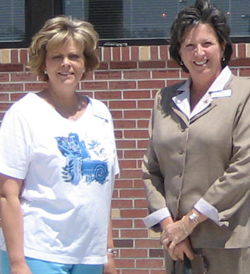 |
Katherine Jones, Ph.D. |
Admitting you made a mistake that could have meant giving a person the wrong medication is even harder.
“It’s easy to blame an individual health care professional for a medical error, but most of the time it’s not their fault,” said Katherine Jones, Ph.D., associate professor in the School of Allied Health Professions. “Ninety-percent of the time the root cause of the error is in the system.”
Dr. Jones discovered this during a two-year Partnerships in Implementing Patient Safety (PIPS) grant funded by the Agency for Healthcare Research and Quality (AHRQ).
Working with an interdisciplinary team of UNMC researchers, Dr. Jones taught health care professionals at 24 hospitals across the state how to apply the principles of a just culture to their institutions.
“Through the PIPS grant we helped them learn how to identify when an individual should be held accountable and when the root cause of an error is within the system of care,” Dr. Jones said.
The research was conducted in 35 critical access hospitals in Nebraska, Wyoming and North Dakota from July 2005 through June 2007.
Working through the Nebraska Center for Rural Health Research, the interdisciplinary team consisted of Dr. Jones as principle investigator, Gary Cochran, Pharm.D., associate professor in the College of Pharmacy; Anne Skinner, a health data analyst in the College of Public Health; and Keith Mueller, Ph.D., associate dean for academic affairs in the College of Public Health.
The PIPS project resulted in the recent release of an online patient safety toolkit intended for use by the nation’s 1,283 rural critical access hospitals. The toolkit can be found at www.unmc.edu/rural/patient-safety.
“The PIPS toolkit includes resources for small rural hospitals to conduct and interpret a rural-adapted version of the AHRQ hospital survey on patient safety culture,” Dr. Jones said. “It also has resources they can use to create an infrastructure for reporting, collecting and analyzing data about voluntarily reported medication errors.”
|
|
The benefits of conducting the survey and collecting such data are well worth it, said Cathy Broz, quality improvement coordinator for Dundy County Hospital in Benkelman, Neb., who participated in the two-year PIPS project.
The small, 14-bed, critical access hospital has subscribed to an environment of learning and open communication for the benefit of their patients.
“It was one of the best things we’ve participated in,” Broz said. “People are able to talk about their errors and learn from them without fear of reprisal.”
After all, she said, if you can’t talk about your mistakes, how are you suppose to improve upon them and prevent them from happening again?
One important aspect of the project was using root cause analysis to really figure out why a mistake was made in the first place.
This led to one very important change in the hospital.
“We discovered that many medication errors and near misses were attributable to distraction caused by the hustle and bustle of the nurse’s station where some of the medications were kept,” said Rita Jones, Dundy County Hospital administrator.
 |
From left: Cathy Broz, left, and Rita Jones of Dundy County Hospital in Benkelman, Neb., participated in the two-year PIPS project. They said the project has helped the hospital staff more effectively confront and deal with medication error issues. |
“Once we focused on the processes of how things were done and not the people, it became clear what we could do to improve,” Rita Jones said.
The hospital continues to use the PIPS toolkit online, she said, and has applied it to other areas.
The PIPS project and online tool kit will continue to be invaluable to the future of small rural hospitals, Dr. Mueller said.
“This work helps these hospitals improve their processes of care, which in turn improve patient safety,” he said. “By knowing more about where there are weaknesses as identified by staff, hospital leadership will know what types of interventions to adopt to improve how patient-care teams function.”